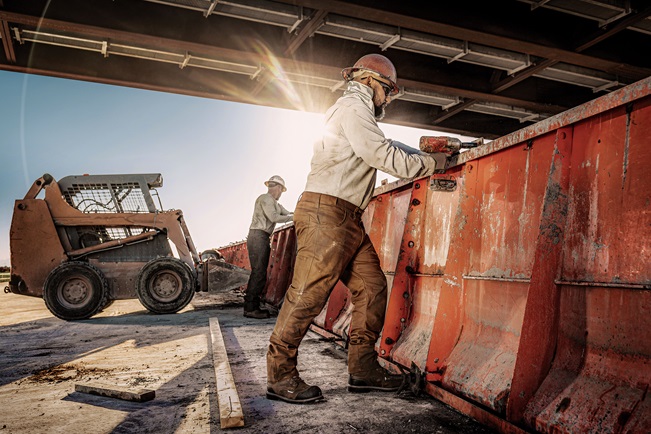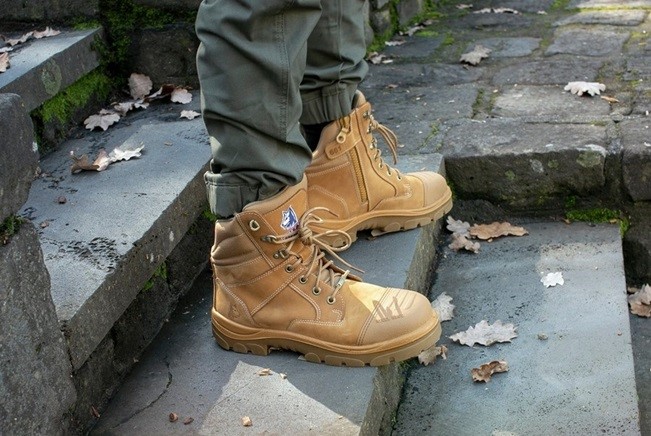Living in the Land Down Under, we’ve all experienced seasons changing faster than you can say “G’day”. In the rugged Australian terrain, the sun can scorch your forehead one moment and a sudden downpour can leave you soaked the next. That said, if your job involves working outdoors, wearing the right clothes is crucial for staying comfortable and protected from the elements.
From braving the blistering heat of the Outback to staying warm on a chilly construction site, the following tips will have you covered, literally. So, before you visit a work clothing shop, here’s what you need to know to create a wardrobe as diverse as the landscapes and elements you’ll be facing on the job.
Stay Sun-Safe

The sun is harsh in Australia, especially if you’re working in the Outback. When that’s the case, avoid bulky, constricting materials and wear workwear shirts, tees and pants with moisture-wicking capabilities and made of lightweight, breathable fabrics. Also, make sure your clothes are rated UPF 50+ as the sun’s rays are so harsh they can penetrate through clothing.
That said, look for a specialised work clothing shop that offers products from renowned brands like Hard Yakka, Bisley, and KingGee. These companies offer garment collections that are UPF certified according to the AS/NZS 4399:2017 standard, giving you peace of mind that the harsh UV rays won’t penetrate through your clothing.
Additionally, you can find garments that come with multiple mesh ventilation points to increase airflow and help you cool off. Besides clothing, another way to stay protected from the sun is to wear a quality outdoor hat like an Akubra.
Resist the Chill
For colder conditions, make sure to have a work jacket that is appropriately insulated. Since being able to move around freely is often necessary when working outside, investing in flexible, insulated coats and hoodies can help you do your job more effortlessly.
Sweatshirts, thermal tops, and fleeces are lightweight layers that can build up to maximum warmth when you are layering. Additionally, layering lets you add or remove items as the day’s temperature fluctuates.
Outdoor workers must always have high-quality, waterproof gear with them when bad weather strikes, especially a waterproof coat or jacket. For protection against summer showers, a lightweight waterproof jacket works just fine. Insulated work coats are also available for winter downpours.
Invest in Heavy-Duty Bottoms
A pair of durable yet comfortable pants and shorts are a must. Hard-wearing materials with double or triple-stitched seams offer long-lasting wear when navigating rough terrain.
Strategically positioned pockets for quick access to necessary tools, vented panels for ventilation, and flexible material mixes for a full range of motion are other crucial features to take into account. And for the winter, make sure you have a trusty pair of pants that offer insulation and are waterproof to prevent you from getting soaked when it rains or snows.
Stay Visible
One of the most crucial things outdoor workers can do to keep themselves safe is to stay visible. Sometimes the weather can make it difficult to see someone wearing dark colours or standing close to anything that makes them blend in. This is when hi-vis workwear steps in.
The purpose of hi-vis clothing is to increase worker visibility. Its ability to stand out from its surroundings and make itself easier to see by others makes it beneficial in a range of scenarios, including emergency situations, low-light conditions, and construction sites.
Hi-vis clothing comes in a variety of styles, such as shirts, hats, and jeans. Research has shown that wearing hi-vis gear can minimise workplace accidents by up to 90%. In addition to putting safety first, you can also order custom hi-vis designs with reflective logos as a great way to promote your business.
Protect Your Feet

So far, we’ve mainly covered clothing, but we can’t skip past shoes. In fact, work boots are among the most crucial pieces of apparel for maintaining workplace safety. Often, they are the ones that prevent slips and falls and injuries from objects falling on your feet.
That said, for the highest level of protection, many outdoor workers choose steel-toe work boots because they offer additional reinforcement in addition to steel toes. A few excellent safety features to look for are cushioned insoles, waterproofing, and non-slip soles. Never forget that these boots should fit and feel good in addition to keeping you safe.
Accessorise
Accessories for outdoor work are specifically made for the conditions you will encounter. This includes beanies that keep you warm in the winter and wide-brimmed hats that shield you from the sun in the summer. You can also wear gloves for warmth, protection, or grip depending on what you are doing.
Sturdy belts that can store tools or accessories can be quite handy for some jobs. And moisture-wicking, cushioned socks are vital for breathability, protection, and comfort during extended periods working outdoors.
























